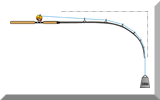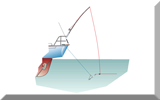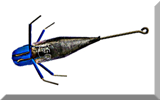- Home
- Knots and Crimping
- Braid Knot
Use the Braid Knot to Connect a Swivel to Braided Line
The Braid Knot is the most secure way of connecting swivels and snaps to braided lines. It's been designed to deal with the special qualities of today's hi-tech braid lines, some of which can have a tendency to slip when tied with other knots.
Even so, this knot like all knots, must be tied with care.
Pull it up slowly and evenly so that the loops snug up neatly and don't overlap.
If it doesn't look right - one of the loops is looser than the others for example - cut it off and start again.
Incidentally, think carefully before using braid lines for hook lengths, as it chafes a lot more easily than other lines.
Boat anglers will use this knot when connecting a snap swivel to the end of their braided reel line, for attaching their terminal rig.
Here's how to tie it ..
 Stage 1
Stage 1First, double the line and pass the resulting loop through the eye of the swivel.
 Stage 2
Stage 2Then, from a point a few centimeters from the eye, take about 8-10 turns back toward the eye, finally threading the doubled line through the gap between the turns and the eye.
Finally, lubricate it with saliva and then cinch it up tight with a steady, continuous pull.
Artwork by Andrew Simpson
This is one of the two braid knots you need to know, the other being for connecting your braided reel line to a monofilament leader. The best knot for that is the Albright Knot.
Braid Line advice...
Remember, if use braid line you'll need a rod with line guides designed for it. Braid line will cut grooves in standard rings which will then overheat and destroy the line - they must be ceramic lined!
Aluminium oxide was I believe, the first ceramic lining to be used, but even harder ceramic materials are used now, such as Silicon Carbide (SiC), Silicon Nitride or Zirconium.
It's also easier to use on a fixed spool spinning reel than on a conventional multiplier reel, where it can embed itself between the coils of line already on the reel spool.
Recent Articles
-
Sea Fishing Rods and Reels Must Be Compatible for a Balanced Outfit
Mar 08, 21 08:30 AM
A quality reel fitted to a quality rod doesn't necessarily make it a quality outfit. Your fishing rods and reels have to be properly matched if you're to get the best out of them, and here’s how -
Essential Lure Fishing Tips That All Saltwater Anglers Should Know
Mar 08, 21 04:51 AM
Which single lure fishing tip applies to trolling, jigging, baitcasting, spinning, fly fishing and any other branch of lure fishing? Well, it is the one at the top of this list -
Vital Jig Fishing Tips That You Really Cannot Afford To Miss!
Mar 07, 21 10:20 AM
Essential jig fishing tips to help you select the right lure for successful jig fishing, together with the techniques required to get the most out of your jig fishing outfit



















New! Comments
Have your say about what you've just read! Leave me a comment in the box below.